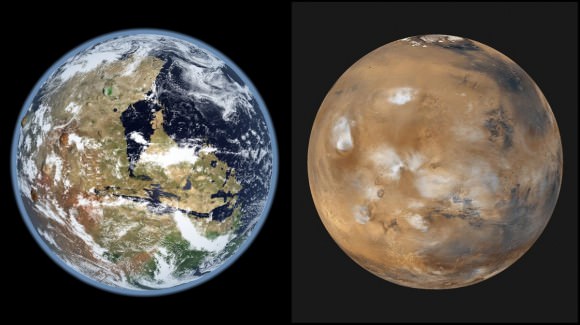
We humans used to take for granted the fact that we live in settled societies, use tools and change the landscape to fit our needs. Also, it is known that in Earth’s history the only people who have developed equipment, automation, electricity and mass communication are hallmarks of industrial civilization. But what if the Earth millions of years ago there was one industrial civilization? If we can find evidence of this in the geological record? Studying the impact of human civilization on the Earth, scientists around imagined how it would be possible to find a civilization and how it may affect the search for extraterrestrial life.
The study was conducted by Gavin Schmidt and Adam Frank, a climatologist from NASA and astronomer of the University of Rochester, respectively.
As they note in their study, the search for life on other planets often requires a search for terrestrial analogues to understand the circumstances under which life could exist in principle. And yet along with this we are trying to find intelligent extraterrestrial life that could communicate with us. It is assumed that any such civilization would first need to develop an industrial basis.
This, in turn, raises the question of how often you may receive a technically advanced civilization. Schmidt and Frank call it the “Silurian hypothesis”. The problem her is that mankind is the only example of a technically advanced species we know about. In addition, human industrial civilization is only the last few hundred years — a tiny drop of time of its existence as a species and a tiny fraction of time from the existence of complex life on Earth.
In their research, the team first noted the importance of the equation In 1961, the astrophysicist Frank Drake developed an equation to estimate the number of advanced civilizations that can exist in the milky Way galaxy. It looks like this: N = R*(fp)(ne)(fl)(fi)(fc)L, decoding of each variable below. The basis of simple statistics, it is easy to calculate that somewhere there may be thousands, even millions of alien civilizations:
- R*: the rate of star formation in our galaxy.
- fp: the percentage of stars with planets.
- ne: number of earth-like planets around every star has planets.
- fl: the percentage of earth-like planets that have developed life.
- fi: the percentage of planets with life on which intelligent life evolved.
- fc: the percentage of intelligent species that have come to create technologies that can detect external forces of civilization like ours. For example, radio signals.
- L: the average number of years required advanced civilization to detect detectable signals.
The Drake equation has become the basis for research, and space technology has deepened the knowledge of scientists on several variables. But to know the possible duration of the existence of other advanced civilizations — L — almost impossible.
In their study, Frank and Schmidt emphasize that the parameters of the equation may change, thanks to the addition of a Silurian hypotheses, as well as the latest discovered ekzoplaneta.
“If during the existence of the planet on it there was a lot of industrial civilizations, the value of (fc) can be higher than unity. This is a particularly important issue in the field of astronomical observations, which fully defines the first three terms that are dependent on astronomical observations. Today it is clear that most stars have planets. Many of these planets located in the habitable zone of a star.”
In short, by improvements in instrumentation and methodology, scientists were able to determine the rate at which stars formed in our galaxy. Moreover, a recent study of extrasolar planets has allowed to estimate the presence of 100 billion potentially habitable planets in our galaxy. If the history of the Earth could find another civilization, this would substantially change the Drake equation.

The researchers then address the question of possible geological traces that have been left by human industrial civilization, and compare these traces with possible events in the geological record. This includes emissions of isotopes of carbon, oxygen, hydrogen and nitrogen, which are the result of greenhouse gas emissions and nitrogen fertilizer.
“Since the mid-18th century, the people threw into the atmosphere more than 0.5 trillion tons of fossil carbon by burning coal, oil and natural gas, far ahead of natural sources of long-term Cycling of carbon. In addition, subject to the deforestation and carbon dioxide in the atmosphere due to burning of biomass”.
Scientists have estimated the increase in the rate of sedimentation in rivers and deposition in coastal environments due to agricultural processes, deforestation and digging of channels. The spread of domesticated animals, rodents and other small animals, as well as the disappearance of certain species of animals, also seen as a direct result of industrialization and urban growth.
The presence of synthetic materials, plastics and radioactive elements (remaining after production of nuclear energy or nuclear tests) will also remain in the geological record. Radioactive isotopes are in the soil millions of years. Finally, it is possible to compare the events of mass extinction in the past, in order to determine whether they can be associated with the time of the collapse of civilization. It turns out that:
“The most obvious class of events is the Paleocene-Eocene thermal maximum, which include smaller hyperthermal phenomena, Cretaceous oceanic anoxic events and important events of the Paleozoic”.
These events are directly associated with the increase in temperature, increase the content of isotopes of carbon and oxygen, the growth of sedimentary rocks and the depletion of ocean oxygen. According to scientists, the events they considered (hyperthermal), demonstrate a similarity with antropoceno imprint (i.e. our age). In particular, the Paleocene-Eocene thermal maximum shows signs that could be associated with anthropogenic climate change.
What is most important geological similarities should be considered in search of anomalies that can be associated with industrial civilization. Roughly speaking, can be seen in the geological record the trace of another human. If found any anomalies, fossils will need to explore for the existence of the appropriate types. However, do not exclude other explanations for anomalies — for example, volcanic and tectonic activity.

Another important fact — the current climate change is happening faster than ever. Beyond Earth this research could help us find life on planets like Mars and Venus that could exist there in the past.
“We want to note that there is strong evidence in favor of the presence of surface water on ancient Mars and the potential habitability of Venus (due to the darkening of the sun and atmosphere with a low content of carbon dioxide), which is supported by recent simulations”, the researchers note. “Therefore, deep drilling in the future will allow to touch the geological history of these issues. Perhaps we will find traces of life or even civilizations”.
Two critical aspects of the Drake equation, which directly determines the ability to find life somewhere in the galaxy, is the huge number of stars and planets, as well as the amount of time that was allotted to the life of the development. Until now it was assumed that at least one planet was supposed to give rise to a reasonable mind, which will learn to create technology and means of communication.
But there is a possibility that civilizations in the galaxy have been and will still be not necessarily existing right now. Who knows? The remains of the once great super-civilizations might be right under our feet.
Could the Earth be other advanced civilization before us?
Ilya Hel